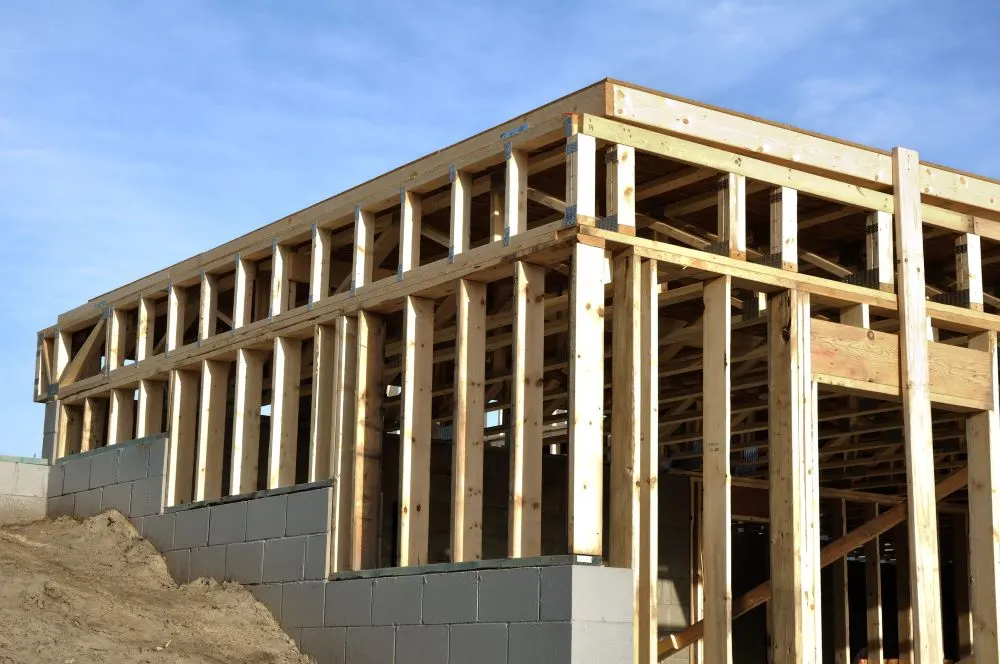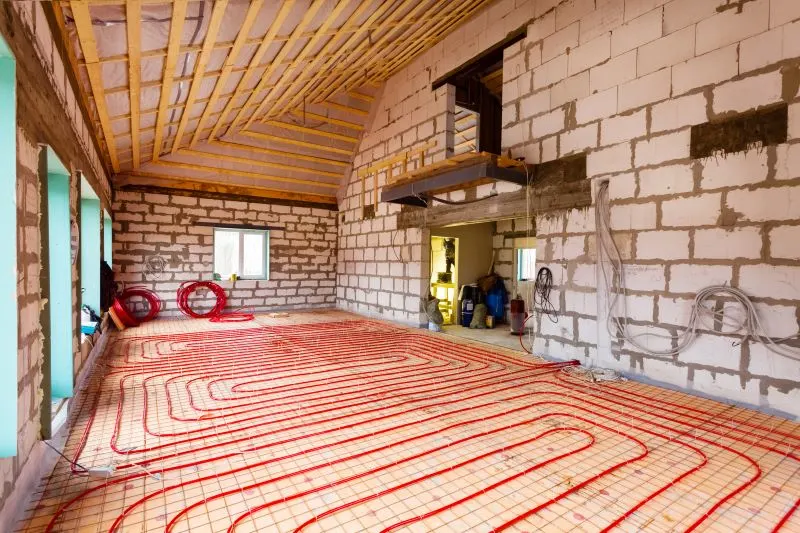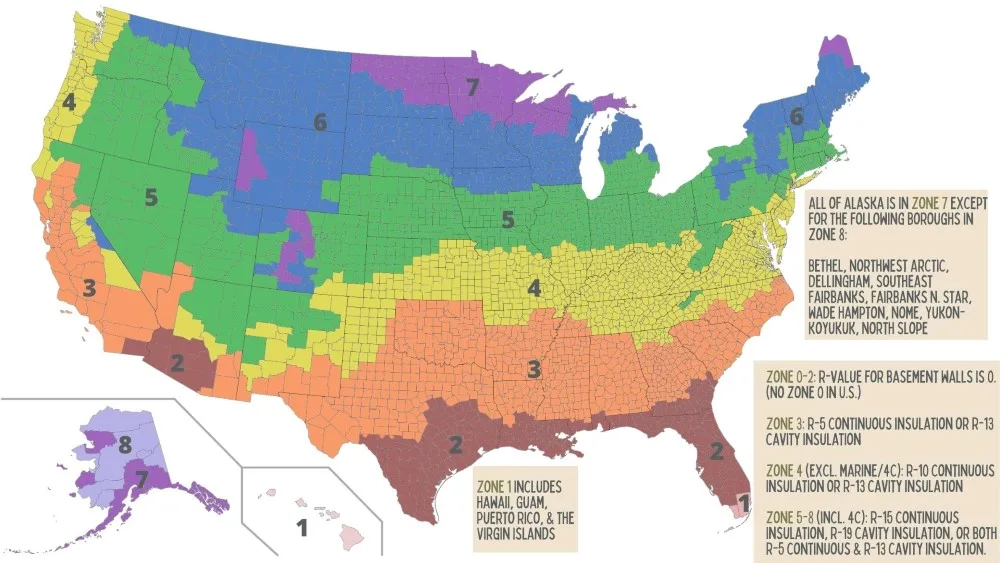There is undeniably a complicated bunch of information surrounding the coding for insulation. The instructions, provisions, and exceptions involved make it a bit of a headache to have to sort through.
Well, here, you will find the information with a linear layout for ease of use. I will highlight and discuss the relevant terminology and sections of the building code for insulating unfinished basements and cover the specific requirements you’ll need to comply with to avoid insulating your basement.

An unfinished basement is unconditioned and should be insulated. There are specific R-values for insulating the thermal envelope based on climate zones. To be exempt from this, a basement must follow all necessary steps for properly sealing the thermal envelope and protecting the house’s conditioned spaces.
Defining a Basement Wall (and Other Important Terms)
The important terms regarding insulation in the International Residential Code (IRC) are found in Section N1101.6 (R202). It is beneficial to know these terms as it help you to navigate which regulations apply to unfinished basements.
Basement Wall
A basement wall is defined as enclosing conditioned space, with half or more of the wall sitting below grade.

Conditioned Space
Conditioned space is within the thermal envelope of a building and is directly or indirectly heated or cooled.
A space is indirectly heated or cooled through communication with a conditioned space through openings and uninsulated ceilings, walls, doors, ducts, pipes, and heating or cooling systems.

R-Value (Thermal Resistance)
Section N1101.6 (R202) (IRC) defines R-value (thermal resistance) as:
“The inverse of the time rate of heat flow through a body from one of its bounding surfaces to the other surface for a unit temperature difference between the two surfaces, under steady state conditions, per unit area (h x ft2 x *F/BTU) [m2 x K)/W].”
In a less mathematical explanation, R-value or thermal resistance refers to the thickness of insulation material and its insulating effect. The higher the R-value of insulation, the more it prevents the transfer of heat.
Required Minimum Basement Insulation
Climate Zones
The minimum requirements for insulation, or R-values, depend on the climate zone you are located in.
There are three category designations with the eight climate zones that refer to moisture divisions:
- A: moist areas.
- B: dry areas.
- C: marine areas.
You can find out what zone and moisture division your state is according to the figure and tables in Section N1101.7 of the IRC.
Minimum Requirements for R-Values
Table N1102.1.3 (R402.1.3) of the IRC gives the minimum requirements for R-values for basement walls according to climate zones. This is represented in the IRC by values for continuous insulation (ci) or cavity insulation.
Continuous insulation is installed on the interior and the exterior surface of the basement walls (you can read more on exterior insulation in Reasons Why The Basement is Warmer Than the Rest of the House), while cavity insulation is the type that is installed between two parts of a wall.

- Zone 0-2: R-value for basement walls is 0. (No Zone 0 in U.S.).
- Zone 3: R-5 continuous insulation or R-13 cavity insulation.
- Zone 4 (excluding marine/4C): R-10 continuous insulation or R-13 cavity insulation.
- Zone 5-8 (including 4C): R-15 continuous insulation, R-19 cavity insulation, or both R-5 continuous and R-13 cavity insulation at once.
Installation Instructions
Insulation must be installed starting from the top of the basement walls and extending 10 ft below the grade level or to the basement floor, depending on which distance is less.
When Is the Insulation Not Required?
Section N1102.2.8 (R402.2.8) makes exceptions from the standard R-value for basements with unconditioned walls. But you must meet every one of the following requirements, or there is no exception.
1. Insulating the Floor Above
The floor above the basement (including the stair stringer) must be properly insulated per the general and specific requirements for floors in Table N1102.1.3 (R402.1.3) and in Section N1102.2.7 (R402.2.7).
Table N1102.1.3 (R402.1.3) shows R-values for floors:
- Zone 1-2: R-13.
- Zone 3-4 (except 4C): R-19.
- Zone 5-6 (including 4C): R-30.
- Zone 7-8: R-38.
Section N1102.2.7 (R402.2.7) of the IRC states that floor cavity insulation must comply with one of the following:
- Insulation must be installed to be in permanent contact with the underside of the subfloor as per manufacturer instruction to achieve the minimum R-value or fill the cavity space.
- Floor framing cavity insulation can be in contact with the top of the sheathing that separates the cavity from the unconditioned basement. The insulation must span the perimeter floor framing member (which must be sealed) from bottom to top.
- Combined cavity and continuous insulation will collectively meet the required R-value. Cavity insulation must be installed in contact with the top of continuous insulation, which must be installed on the underside of the framing that separates the cavity from the basement.
This protects against the exchange of heat and cold between the unconditioned, unfinished basement and the conditioned area above. The insulation helps maintain the temperature balance in your home when an unconditioned basement would constantly cool or heat it.
2. Exposed Surfaces
There must be no uninsulated surfaces on ducts and heating equipment (hot water or hydronic) exposed to your basement.
For ducting, having no protective insulation will allow the exchange of heat and cold into and out of the ducts.
Having exposed heating equipment will allow the transfer of heat from those appliances into the basement. This means that you’ll have to pay higher utility bills for the extra energy to compensate for heat loss and you might end up with an excessively hot basement, even in winter.
3. Diffusers
You may not have any HVAC return or supply diffusers for the basement.
Diffusers allow air to enter (supply) or exit (return) a room through the ventilation system.
In an unfinished basement, you will be supplying conditioned air into a room that isn’t sealed to preserve conditioning, or you will be allowing unconditioned air to enter your HVAC system.
4. Protecting Conditioned Spaces
You must protect your conditioned spaces by installing insulation on walls around the stairs and walls next to conditioned spaces, according to the instructions in Section N1102.1.3 and Section N1102.2.
R-values for Wood Frame Walls
- Zone 1-2:
- R-13 cavity.
- Or R-0 cavity + R-10 continuous.
- Zone 3:
- R-20 cavity.
- Or R-13 cavity + R-5 continuous.
- Or R-0 cavity + R-15 continuous.
- Zone 4-5:
- R-20 cavity.
- Or R-13 cavity + R-10 continuous.
- Or R-0 cavity + R-15 continuous.
- Zone 6-8:
- R-20 cavity + R-5 continuous.
- Or R-13 cavity + R-10 continuous.
- Or R-0 cavity + R-20 continuous.
R-Values for Mass Walls
For mass walls, there are two R-values. The second refers to the value for situations when more than half of the insulation is on the interior of a mass wall.
- Zone 1: R-3/R-4.
- Zone 2: R-4/R-6.
- Zone 3-4 (excluding 4C): R-8/R-13.
- Zone 5 (including 4C): R-13/R-17.
- Zone 6: R-15/R-20.
- Zone 7-8: R-19/R-21.
Mass walls must also have a heat capacity of at least 6 Btu/ft2× °F (123 kJ/m2× K) if they are a component of the thermal envelope, as per Section N1102.2.5 (R402.2.5) of the IRC.
5. Doors to Conditioned Spaces
The doors that open to conditioned spaces must be properly insulated (Section N1102.1.3 and Section N1102.2) and weatherstripped (Section N1102.4).
This is done to preserve the thermal envelope of your house and keep conditioned air inside.
Door Insulation
Section N1102.2.4 of the IRC states that doors between conditioned and unconditioned spaces must be insulated to match the R-value of the ceiling or wall in which they are installed. This means that you will follow the floor and ceiling R-values found in Table N1102.1.3 (R402.1.3). For the basement, you will be following the R-value of the floor above.
Door Sealing
According to Section N1102.4.1.1 (R402.4.1.1), the components of the thermal envelope (including doors between conditioned spaces and unconditioned basements) must be installed as per manufacturer instructions and Table N1102.4.1.1 (R402.4.1.1).
To comply with the code and prevent the exchange of conditioned and unconditioned air, you must seal the spaces around the door jambs.
Sealing and insulating the basement door will obviously affect the ventilation in the basement, so just make sure that you account for this to prevent moisture build-up in the basement. This is particularly important if your basement has no windows. Please note that while not insulating your basement can, in this way, increase humidity in your basement, insulating it will not reduce humidity.
6. Thermal Envelope
The house’s thermal envelope that separates the basement from conditioned spaces must comply with Section N1102.4 of the IRC.
Section N1102.4.1 (IRC) states that the thermal envelope must comply with Sections N1102.4.1.1 to N1102.4.1.3. Section N1102.4.1.1 (R402.4.1.1) requires that the thermal envelope components comply with manufacturer instructions and Table N1102.4.1.1 (R402.4.1.1).
There must be a continuous air barrier with sealed joints or breaks, and no air-permeable insulation can be used as part of the sealing. There must also be contraction and expansion allowance for sealing between different materials for airtightness.
Section N1102.4.1.2 (R402.4.1.2) and Section N1102.4.1.3 (R402.4.1.3) cover air leakage testing and rates. Your house must be tested for air leakage, which, in code-compliant dwelling units, should be a maximum of 5.0 air changes per hour in Zone 1-2, and 3.0 in Zone 3-8. It should never exceed 5.0 air changes/hour or 0.28 CFM of the enclosure area.
If you plan on heating your unfinished basement, then you should at least insulate it properly, beyond what is code-required. It might cost you some cash outlay, but it will make the heating process efficient and effective.
Insulation is just as important in summer as it is in winter.
Sources
https://aerolite.org.za/ceiling-insulation-r-value/
https://www.bradfordinsulation.com.au/information-centre/how-insulation-works/what-is-r-value
https://basc.pnnl.gov/images/iecc-climate-zone-map
https://www.greenbuildingadvisor.com/article/all-about-climate-zones



